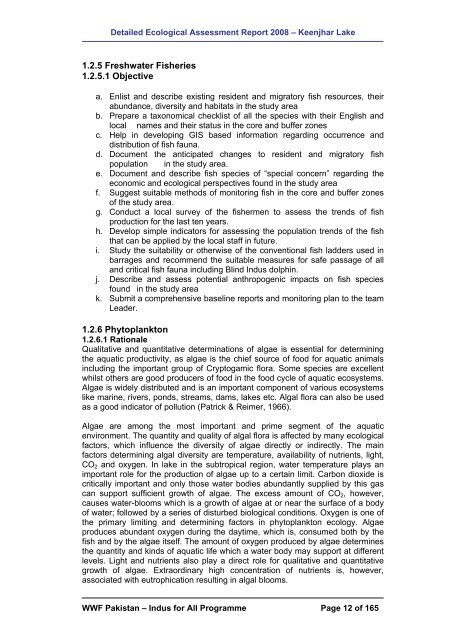Untitled - WWF - Pakistan
Untitled - WWF - Pakistan
Untitled - WWF - Pakistan
Create successful ePaper yourself
Turn your PDF publications into a flip-book with our unique Google optimized e-Paper software.
Detailed Ecological Assessment Report 2008 – Keenjhar Lake<br />
1.2.5 Freshwater Fisheries<br />
1.2.5.1 Objective<br />
a. Enlist and describe existing resident and migratory fish resources, their<br />
abundance, diversity and habitats in the study area<br />
b. Prepare a taxonomical checklist of all the species with their English and<br />
local names and their status in the core and buffer zones<br />
c. Help in developing GIS based information regarding occurrence and<br />
distribution of fish fauna.<br />
d. Document the anticipated changes to resident and migratory fish<br />
population in the study area.<br />
e. Document and describe fish species of “special concern” regarding the<br />
economic and ecological perspectives found in the study area<br />
f. Suggest suitable methods of monitoring fish in the core and buffer zones<br />
of the study area.<br />
g. Conduct a local survey of the fishermen to assess the trends of fish<br />
production for the last ten years.<br />
h. Develop simple indicators for assessing the population trends of the fish<br />
that can be applied by the local staff in future.<br />
i. Study the suitability or otherwise of the conventional fish ladders used in<br />
barrages and recommend the suitable measures for safe passage of all<br />
and critical fish fauna including Blind Indus dolphin.<br />
j. Describe and assess potential anthropogenic impacts on fish species<br />
found in the study area<br />
k. Submit a comprehensive baseline reports and monitoring plan to the team<br />
Leader.<br />
1.2.6 Phytoplankton<br />
1.2.6.1 Rationale<br />
Qualitative and quantitative determinations of algae is essential for determining<br />
the aquatic productivity, as algae is the chief source of food for aquatic animals<br />
including the important group of Cryptogamic flora. Some species are excellent<br />
whilst others are good producers of food in the food cycle of aquatic ecosystems.<br />
Algae is widely distributed and is an important component of various ecosystems<br />
like marine, rivers, ponds, streams, dams, lakes etc. Algal flora can also be used<br />
as a good indicator of pollution (Patrick & Reimer, 1966).<br />
Algae are among the most important and prime segment of the aquatic<br />
environment. The quantity and quality of algal flora is affected by many ecological<br />
factors, which influence the diversity of algae directly or indirectly. The main<br />
factors determining algal diversity are temperature, availability of nutrients, light,<br />
CO2 and oxygen. In lake in the subtropical region, water temperature plays an<br />
important role for the production of algae up to a certain limit. Carbon dioxide is<br />
critically important and only those water bodies abundantly supplied by this gas<br />
can support sufficient growth of algae. The excess amount of CO2, however,<br />
causes water-blooms which is a growth of algae at or near the surface of a body<br />
of water; followed by a series of disturbed biological conditions. Oxygen is one of<br />
the primary limiting and determining factors in phytoplankton ecology. Algae<br />
produces abundant oxygen during the daytime, which is, consumed both by the<br />
fish and by the algae itself. The amount of oxygen produced by algae determines<br />
the quantity and kinds of aquatic life which a water body may support at different<br />
levels. Light and nutrients also play a direct role for qualitative and quantitative<br />
growth of algae. Extraordinary high concentration of nutrients is, however,<br />
associated with eutrophication resulting in algal blooms.<br />
<strong>WWF</strong> <strong>Pakistan</strong> – Indus for All Programme Page 12 of 165
















